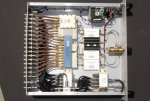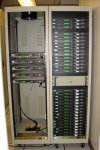Ubbe
Member
If you consider that HPN-30118 then you can take off its lid and you'll see one of the biggest coils at the female BNC connector that goes to ground. Try separating the turns a little. You'll see that being done to other coils as well to tune them. You'll see the two other biggest coils at the male BNC connector but don't touch those. When you seperate the turns it will loose some inductance and do not couple the low frequency part of the filter to ground as much, and the 86Mhz frequency will not be attenuated as much but will also pass a bit more of the 88Mhz range.
I don't have that strong FM broadcast signals at my place, all signals are low, so I use filters between amplifier and receiver and when measure the sensitivty by inserting a signal in parallell to the antenna coax I get no change in sensitivity or intermod with any scanner regardless of where I install the filter. Then any filters insertion loss are of no concern if the amplifier are first in the signal chain from the antenna . So try that setup first to see if the amplifier can handle it. Using a PGA103+ it needs to be a pretty strong signal for that to happen, perhaps using a discone, that works best on the FM band, and at the same time being close to a FM broadcast transmitter can make it happen.
/Ubbe
I don't have that strong FM broadcast signals at my place, all signals are low, so I use filters between amplifier and receiver and when measure the sensitivty by inserting a signal in parallell to the antenna coax I get no change in sensitivity or intermod with any scanner regardless of where I install the filter. Then any filters insertion loss are of no concern if the amplifier are first in the signal chain from the antenna . So try that setup first to see if the amplifier can handle it. Using a PGA103+ it needs to be a pretty strong signal for that to happen, perhaps using a discone, that works best on the FM band, and at the same time being close to a FM broadcast transmitter can make it happen.
/Ubbe





